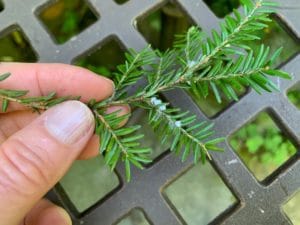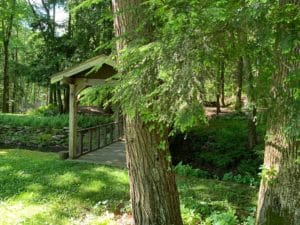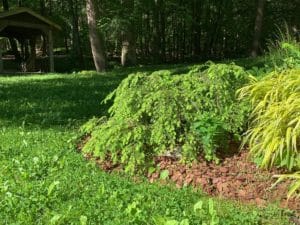Hello Fellow Readers, Robert, an associate landscape installer, asked about a client’s Canadian hemlock installed about two years ago dying from the bottom up.
Likely causes of Hemlocks Dying from the bottom up
When he first described the dilemma, I thought the issue might not be enough sunlight. Hemlocks in our woodland are fully dressed at the top-tier, but the lower branches have died back because of the dense shade of surrounding trees. If the trees are in the vicinity of road salt, it could kill the lower limbs, even kill the tree.
Robert sent photographic evidence that reminds me of the dreaded canker disease we chatted about a few years back. It attacks primarily blue spruce, and sometimes Norway spruce killing them from the bottom up. I had never heard it attacking hemlock, so I put on my Sherlock Holmes hat and found the fungus can strike hemlocks as well.
Hemlock woolly adelgid is largely eraticated
For sure, Robert’s hemlock dilemma is not woolly adelgid that took down hundreds of stands of the indigenous beauties in years past. Woolly adelgid is a sucking insect. The egg sacs look like fuzzy white cotton on the underside of branches, which would have been noticeable before the client’s lower limbs became naked.
Thankfully much of the adelgid dilemma local to me has been eradicated with biological controls using predatory beetles that feed on them, which brings back a memory of my workaround. We bought a commercial grade power washer to knock the little suckers off our thirty-foot trees. Then I applied dormant oil using the same hefty machine. Maneuvering the hose felt like taming a dragon that kept knocking me to the ground. But our hemlocks lived.
About Canadian Hemlock
Canadian Hemlock (Tsuga canadensis), native to the United States, is the one most often planted. The upper side of their needles are dark green, and the underside is lighter in color, which seems to dance in the wind. Unlike Norway spruce that looks like Christmas trees, hemlock has a more graceful pyramidal shape when they’re young. As they mature, their branching becomes pendulous, which makes for an elegant screening in groupings or as an accent plant. They grow to 40 to 75 feet in maturity with a spread of 25 to 35 feet and are hardy from Zones 3B to 7(8).
Unlike most conifers, hemlocks can tolerate shade though they grow well in full sun too with good drainage and protection from drying winds. They struggle in heavy clay soil that doesn’t drain well. Nor do hemlocks tolerate extended drought. I wonder if the last two growing seasons of excessive rain and the likelihood of clay soil there contributed to Robert’s client’s naked needled plants.
Fabrella needle blight
My Sherlock Holmes hat snooped further, finding Penn State Extension’s website. I came across Fabrella needle blight, also a fungus, which may be the culprit of Robert’s dilemma. Look for the tiny dots on the underside of the needles that start white and then darken to black. If infected, the lower part of the tree turns brown, and the needle drop in late summer. There is no control recommended as it doesn’t devastate a tree unless it is under stress from other things such as drought or insects.
Per Sherlock Holmes, “How often have I said to you that when you have eliminated the impossible, whatever remains, however improbable, must be the truth?” (The Sign of the Four – 1890).
The truth is with the right cultural conditions – good drainage, enough sun, and no salt – hemlocks are a reliable and graceful evergreen tree—and one of my very favs. Garden Dilemmas? AskMaryStone@gmail.com (and now on your favorite Podcast App.)
More about the Dreaded Canker Disease
Click through to a previous column featuring our native hemlock titled Talking to Trees on Arbor Day
Link to the Penn State Extension’s list of Hemlock Diseases






Hi Mary– You mentioned above that the adelgid has been eradicated with a predatory beetle. I know that the entomologists are working on that but I don’t think there has been much success yet, and definitely not on a large, state-wide scale. I wish there was. There are very effective systemic insecticide treatments available that control HWA. Oil is not used much anymore because of these treatments. Bayer tree and shrub control contains an insecticide that can be drenched around the bases of the tree and control HWA for up to 7 years. It’s pretty cheap too.
Also, from the photo, it looks like deer damage. Deer love hemlocks and all the damage is in the deer “zone” 4-5′ from the ground.
Hello Ben, Thanks so much for writing and sharing your knowledge. I hadn’t thought about deer damage when I wrote the column, but you are right. The trees are in Lake Mohawk, NJ, which is one of the most “challenging” areas to garden in because of the darn deer!
Interestingly I have no deer browse on my hemlocks here in Blairstown NJ – a few miles from the Appalachian Trail where deer also leave the native beauties be. It’s at the Blue Mountain Lake area (NJ) of the Delaware Water Gap National Recreation Area, where I’ve observed an incredible turnaround of the adelgid impacting hemlocks there. I thought from predatory beetles, per a forester I met while cross country skiing the trails. Thanks again for your insights! And for reading my column :^), Mary